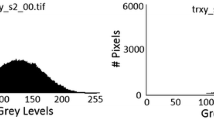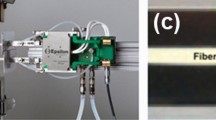Abstract
We describe non-contact scanning with a confocal laser probe to measure surface contours for application to residual stress measurement. (In the recently introduced contour method, a part is cut in two with a flat cut, and the part deforms by relaxation of the residual stresses. A cross-sectional map of residual stresses is then determined from measurement of the contours of the cut surfaces.) The contour method using laser scanning is validated by comparing measurements on a ferritic steel (BS 4360 grade 50D) weldment with neutron diffraction measurements on an identical specimen. Compared to lower resolution touch probe techniques, laser surface-contouring allows more accurate measurement of residual stresses and/or measurement of smaller parts or parts with lower stress levels. Furthermore, to take full advantage of improved spatial resolution of the laser measurements, a method to smooth the surface contour data using bivariate splines is developed. In contrast to previous methods, the spline method objectively selects the amount of smoothing and estimates the uncertainties in the calculated residual stress map.
Similar content being viewed by others
References
Prime, M.B., “Cross-sectional Mapping of Residual Stresses by Measuring the Surface Contour After a Cut,”Journal of Engineering Materials and Technology,123 (2),162–168 (2001).
Prime, M.B., U.S. Patent 6,470,756 (2002).
Withers, P.J. andBhadeshia, H.K.D.H., “Overview—Residual Stress Part 1—Measurement Techniques,”Materials Science and Technology,17 (4),355–365 (2001).
Smith, D.J., Bouchard, P.J., andGeorge, D., “Measurement and Prediction of Residual Stresses in Thick-section Steel Welds,”Journal of Strain Analysis for Engineering Design,35 (4),287–305 (2000).
Virkkunen, I., “Thermal Fatigue of Austenitic and Duplex Stainless Steels,” Doctoral Dissertation at Helsinki University of Technology (2001).
Zhang, Y., Fitzpatrick, M.E., andEdwards, L., “Measurement of the Residual Stresses around a Cold Expanded Hole in an EN8 Steel Plate Using the Contour Method,”Materials Science Forum,404–407,527–532 (2002).
Prime, M.B. andMartineau, R.L., “Mapping Residual Stresses After Foreign Object Damage Using The Contour Method,”Materials Science Forum,404–407,521–526 (2002).
Kaplan, H., “Laser Gauging Enters a Submicron World,”Photonics Spectra,31 (6),67–68 (1997).
Zhao, Z.B., Hershberger, J., Yalisove, S.M., andBilello, J.C., “Determination of Residual Stress in Thin Films: A Comparative Study of X-Ray Topography Versus Laser Curvature Method,”Thin Solid Films,415 (1–2),21–31 (2002).
Nelson, D.V. andMcCrickerd, J.T., “Residual Stress Determination Through Combined Use of Holographic-interferometry and Blind-hole Drilling,” EXPERIMENTAL MECHANICS26 (4),371–378 (1986).
Wang B.S., Chiang, F.P., andWu, S.Y., “Whole-field Residual Stress Measurement in Rail Using Moire Interferometry and Twyman/Green Interferometry Via Thermal Annealing,” EXPERIMENTAL MECHANICS,39 (1),71–76 (1999).
Pechersky, M.J., Miller, R.F., andVikram, C.S., “Residual Stress Measurements with Laser Speckle Correlation Interferometry and Local Heat-Treating,”Optical Engineering,34 (10),2964–2971 (1995).
Buitrago, J. andDurelli, A.J., “Interpretation of Shadow-moire Fringes,” EXPERIMENTAL MECHANICS,18, (6),221–226 (1978).
Pirodda, L., “Shadow and Projection Moire Techniques for Absolute or Relative Mapping of Surface Shapes,”Optical Engineering,21 (4),640–649 (1982).
Hughes, D.J., Webster, P.J., andMills, G., “Ferritic Steel Welds—A Neutron Diffraction Standard,”Materials Science Forum,404–407,561–566 (2002).
Webster, P.J., “The Neutron Strain Scanner,”Kerntechnik,56,178–182 (1990).
Benedict, G.F., Nontraditional Manufacturing Processes, Marcel Dekker, New York (1987).
Cheng, W., Finnie, I., Gremaud, M., andPrime, M.B., “Measurement of Near Surface Residual Stresses Using Electric Discharge Wire Machining,”Journal of Engineering Materials and Technology,116 (1),1–7 (1994).
Sebring, R., Anderson, W., Bartos, J., Garcia, F., Randolph, B., Salazar, M., and Edwards, J. “Non-contact Optical Three Dimensional Liner Metrology,” Proceedings of the 28th IEEE International Conference on Plasma Science and The 13th IEEE International Pulsed Power Conference, Las Vegas, NV, June 17–22, 2001, 1414–1417 (2001).
DeWald, A.T. and Hill, M.R., “Residual Stress in a Thick Steel Weld Determined Using the Contour Method,” University of California, Davis report for Los Alamos National Laboratory Contract 32390-001-01-49 (October 2001).
DeBoor, C., MATLAB Spline Toolbox User's Guide, The Math Works, Inc., Natick, MA (2000).
Cao, Y.P., Hu, N., Lu, J., Fukunaga, H., andYao, Z. H., “An Inverse Approach for Constructing the Residual Stress Field Induced by Welding,”Journal of Strain Analysis for Engineering Design,37 (4),345–359 (2002).
Hill, M.R. andLin, W.Y., “Residual Stress Measurement in a Ceramic-metallic Graded Material,”Journal of Engineering Materials and Technology,124 (2),85–191 (2002).
Webster, G.A. andEzeilo, A.N., “Residual Stress Distributions and Their Influence on Fatigue Lifetimes,”International Journal of Fatigue,23 (SS),S375-S383 (2001).
Gasvik, K.J., , 2nd edition, Wiley, Chichester, UK (1995).
Dainty, J.C., Current Trends in Optics, Academic, San Diego, CA (1994).
Nobre, J.P., Kornmeier, M., Dias, A.M., andScholtes, B., “Use of the Hole-drilling Method for Measuring Residual Stresses in Highly Stressed Shot-Peened Surfaces,” EXPERIMENTAL MECHANICS,40 (3),289–297 (2000).
Prime, M.B., Newborn, M.A., andBalog, J.A., “Quenching and Cold-Work Residual Stresses in Aluminum Hand Forgings: Contour Method Measurement and FEM Prediction,”Materials Science Forum,426–432,435–440 (2003).
Author information
Authors and Affiliations
Rights and permissions
About this article
Cite this article
Prime, M.B., Sebring, R.J., Edwards, J.M. et al. Laser surface-contouring and spline data-smoothing for residual stress measurement. Experimental Mechanics 44, 176–184 (2004). https://doi.org/10.1007/BF02428177
Received:
Accepted:
Issue Date:
DOI: https://doi.org/10.1007/BF02428177




